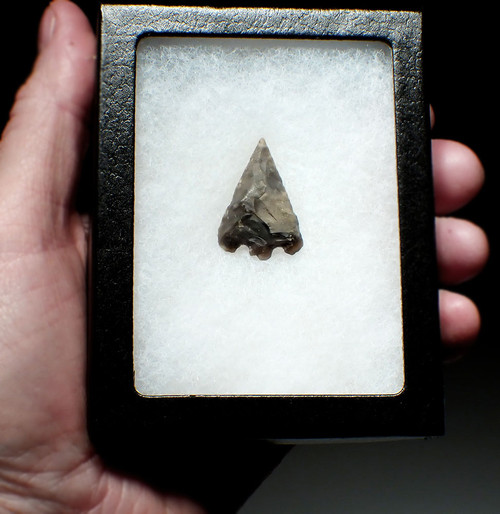Product Description
SEE MORE EUROPEAN BRONZE AGE ARTIFACTS
The Early Bronze Age Bell Beaker Culture in Great Britain (circa 2450-1800 BC) was a period of change including the introduction of ‘Beaker’ style pottery and the advent of metalworking. Bronze metal objects were extremely rare and expensive so flint tools continued to be an important part of people’s lives despite the advent of this metallurgy. Archaeological evidence suggests flint tools were used in both, hunting activities, and as weapons in warfare. Flint arrowheads were the most common objects, as well as flint flake tools such as scrapers. A flint dagger was an important personal tool of those who could afford one, or skillful enough to flake one themselves. These daggers were very scarce, considered objects of great prestige, and played significant roles in both, life and death in the Early Bronze Age.
One of the rarest flint objects of the Early Bronze Age Bell Beaker Culture in Great Britain, are bifacial daggers. Compared to numerous arrowheads that were made, a dagger was a prestige tool / weapon, not necessarily needed for daily survival. On the rare occasions they are found, rarely are they complete. Complete, undamaged bifacial flint daggers from this era are ESPECIALLY RARE! Bell Beaker Early Bronze Age flint tools and weapons are rarely, if ever seen on the private market, making this an extraordinarily rare opportunity for a museum or highly advanced collector to add an important addition to their collection. Out of the very limited collection of tools we acquired long ago, from an old British collection of Bell Beaker flint tools, this was the only dagger!
Made with exquisite symmetry in an offset lozenge form, this SUPERB bifacial dagger has a pointed base that would have been inserted into a wood, bone or ivory handle, and secured with animal sinew. The blade is complete to the very tip. One side has a raised ridge running the length of the blade, an important flaked feature that added strength to the blade when in heavy use. As a stabbing weapon, this profile feature would have been critically important! The cutting edges show extensive use wear and ancient re-sharpening. The golden brown flint possesses a fantastic natural luster from soil sheen which highlights the masterful flaking. This flint dagger was found in Romford Essex, England, some time during the late 19th century to early 20th century. From a very old private British collection.
Original ground minerals and sediment are still intact in hinge fractures - an indicator ONLY seen in AUTHENTIC specimens. Genuine tools from the Bell Beaker Culture represent an excellent opportunity to acquire a artifacts from some of the Europe's earliest metal societies where stone was still being used as the introduction of copper and bronze began to dominate tool technology.
HISTORY
The Bell Beaker culture, also known as the Bell Beaker complex or Bell Beaker phenomenon, is an archaeological culture named after the inverted-bell beaker drinking vessel used at the very beginning of the European Bronze Age, arising from around 2800 BC. Bell Beaker culture lasted in Britain from c. 2450 BC, with the appearance of single burial graves, until as late as 1800 BC, but in continental Europe only until 2300 BC, when it was succeeded by the Unetice culture. The culture was widely dispersed throughout Western Europe, being present in many regions of Iberia and stretching eastward to the Danubian plains, and northward to the islands of Great Britain and Ireland, and was also present in the islands of Sardinia and Sicily and some coastal areas in north-western Africa. The Bell Beaker culture was partly preceded by and contemporaneous with the Corded Ware culture, and in north-central Europe preceded by the Funnelbeaker culture.
In its early phase, the Bell Beaker culture can be seen as the western contemporary of the Corded Ware culture of Central Europe. From about 2400 BC the Beaker folk culture expanded eastwards, into the Corded Ware horizon. In parts of Central and Eastern Europe, as far east as Poland, a sequence occurs from Corded Ware to Bell Beaker. This period marks a period of cultural contact in Atlantic and Western Europe following a prolonged period of relative isolation during the Neolithic.
In its mature phase, the Bell Beaker culture is understood as not only a collection of characteristic artifact types, but a complex cultural phenomenon involving metalwork in copper and gold, long-distance exchange networks, archery, specific types of ornamentation, and (presumably) shared ideological, cultural and religious ideas, as well as social stratification and the emergence of regional elites. A wide range of regional diversity persists within the widespread late Beaker culture, particularly in local burial styles (including incidences of cremation rather than burial), housing styles, economic profile, and local ceramic wares (Begleitkeramik).
 US DOLLAR
US DOLLAR
 EURO
EURO
 AUSTRALIAN DOLLAR
AUSTRALIAN DOLLAR
 CANADIAN DOLLAR
CANADIAN DOLLAR
 POUND STERLING
POUND STERLING




























